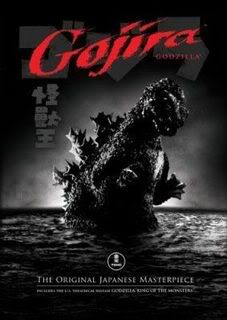
"Did you see that? That was nothing, but that's how it always begins. Very small."
- Egg Shen (Victor Wong) from the John Carpenter classic, Big Trouble In Little China.
Individual phobias may vary, but human beings tend to fear two things universally: the unknown and the notion that one day something may be on a higher rung on the food chain than we are.
Few films encapsulate these elements better than the “atomic fables” of the mid to late 1950’s. In 1954, two significant films from this sub-genre were released nearly simultaneously and their influence is felt even to the present day.
Toho’s kaiju epic, Gojira (better known as Godzilla), and Warner Brothers’ blueprint for the big bug movie, THEM.
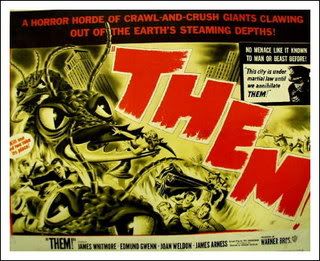
- Egg Shen (Victor Wong) from the John Carpenter classic, Big Trouble In Little China.
Individual phobias may vary, but human beings tend to fear two things universally: the unknown and the notion that one day something may be on a higher rung on the food chain than we are.
Few films encapsulate these elements better than the “atomic fables” of the mid to late 1950’s. In 1954, two significant films from this sub-genre were released nearly simultaneously and their influence is felt even to the present day.
Toho’s kaiju epic, Gojira (better known as Godzilla), and Warner Brothers’ blueprint for the big bug movie, THEM.

You really do have to marvel at the beauty of the respective formulae in both movies. Talk to any High School Biology teacher and they’ll give you a laundry list of implausibilities as to why there should be no such things as giant ants or rampaging radioactive dinosaurs, but these two masterpieces play on the fear of the atom so well that rational science goes straight out of the window.
To paraphrase Stephen King’s musing on Coleridge; disbelief isn’t light, it is heavy and the ability of these two movies to hook you in immediately is nothing short of astounding.
When the atom warps nature’s design, all hell breaks loose.
Perhaps I’m reading too much into it but as I re-visited these films recently, I had to wonder if the respective antagonists in these films were products of deliberate irony or just the result of some huge pitch meeting. I’d like to think that more thought went into the concepts, but I do tend to give the movie business credit for being smarter than it actually is.

To paraphrase Stephen King’s musing on Coleridge; disbelief isn’t light, it is heavy and the ability of these two movies to hook you in immediately is nothing short of astounding.
When the atom warps nature’s design, all hell breaks loose.
Perhaps I’m reading too much into it but as I re-visited these films recently, I had to wonder if the respective antagonists in these films were products of deliberate irony or just the result of some huge pitch meeting. I’d like to think that more thought went into the concepts, but I do tend to give the movie business credit for being smarter than it actually is.

Take the case of THEM.
Mankind facing extinction at the mandibles of giant ants is one of the best examples of role reversal ever. No one really remembers the last time they stepped on an ant because the run of the mill human being that isn’t an entomologist doesn’t place that much weight on the existence of such a lowly creature.
Respect comes from parity or the acknowledgment of inferiority, so when mankind finds out that it may have to compete for its status as dominant species, it stands up and takes notice.

Mankind facing extinction at the mandibles of giant ants is one of the best examples of role reversal ever. No one really remembers the last time they stepped on an ant because the run of the mill human being that isn’t an entomologist doesn’t place that much weight on the existence of such a lowly creature.
Respect comes from parity or the acknowledgment of inferiority, so when mankind finds out that it may have to compete for its status as dominant species, it stands up and takes notice.

Gojira is equally ironic. In the movie, our nuclear fire spouting antagonist is called everything from a dinosaur to a monster god, but for all intents and purposes it really does act like the dragons of yore.
The thing to note is that in most Asian cultures, dragons are wise, celestial creatures and Japanese dragons in particular tend to have a role as water deities that preserve and sustain life.
Gojira, however, acts like a traditionally European dragon that brings misery and death, as if to imply that the product of the Manhattan Project had the capability of not only corrupting nature but twisting traditional symbols from Japanese folklore.
One of the films I reviewed earlier for this project (Threads) tackles the subject of the destruction of culture as a result of an atomic war, so it is interesting to see Gojira (possibly without meaning to) pay lip service to this issue head on in 1954.

The thing to note is that in most Asian cultures, dragons are wise, celestial creatures and Japanese dragons in particular tend to have a role as water deities that preserve and sustain life.
Gojira, however, acts like a traditionally European dragon that brings misery and death, as if to imply that the product of the Manhattan Project had the capability of not only corrupting nature but twisting traditional symbols from Japanese folklore.
One of the films I reviewed earlier for this project (Threads) tackles the subject of the destruction of culture as a result of an atomic war, so it is interesting to see Gojira (possibly without meaning to) pay lip service to this issue head on in 1954.

You also have to admire the frankness of both of these films. One of the most iconic scenes in movie history is the scene where the daughter of the dead FBI agent (Sandy Dresher) comes out of her near-catatonia (induced by watching her parents devoured by the ants) when Dr. Medford (Edmund Guenn) tries to revive the child by giving her a whiff of formic acid. (i.e. ants secrete formic acid as both an attack and defense mechanism).
Not only does Medford succeed in bringing the girl out of her stupor, but smell of formic acid also send the poor kid into a blind panic and she begins to scream, "Them!" over and over again. Absolutely blood chilling.
It's at that point when you begin to understand that ants as antagonists are great because the goddamn things are hell bent on the survival of the colony at the expense of any nearby humans regardless of age, race, or sex.
If the ants have to eat your children in order to survive, then so be it.
"Them" will not discriminate.
In retrospect, it was a pretty ballsy move on the part of Warner Brothers to simulate putting a child in peril like that, but the concept of "everyone as prey" drives the fright train with terrifying efficiency for many other sci-fi horror gems like THEM, such as The Blob (made in 1958 and featuring Steve McQueen in one of his first leading roles) and The Blob's superior 1988 reboot featuring Kevin Dillon and Shawnee Smith.

Not only does Medford succeed in bringing the girl out of her stupor, but smell of formic acid also send the poor kid into a blind panic and she begins to scream, "Them!" over and over again. Absolutely blood chilling.
It's at that point when you begin to understand that ants as antagonists are great because the goddamn things are hell bent on the survival of the colony at the expense of any nearby humans regardless of age, race, or sex.
If the ants have to eat your children in order to survive, then so be it.
"Them" will not discriminate.
In retrospect, it was a pretty ballsy move on the part of Warner Brothers to simulate putting a child in peril like that, but the concept of "everyone as prey" drives the fright train with terrifying efficiency for many other sci-fi horror gems like THEM, such as The Blob (made in 1958 and featuring Steve McQueen in one of his first leading roles) and The Blob's superior 1988 reboot featuring Kevin Dillon and Shawnee Smith.

The monster known as Gojira is also an equal opportunity destroyer, but the true bravery of this film springs from the honest dialogue concerning nuclear proliferation.
In order to stop Gojira, it dawns on Dr. Daisuke Serizawa (the late, great Akihiko Hirata) that he will have to create a weapon far worse than the one that created Gojira in order to destroy the beast (the dreaded OXYGEN DESTROYER!), and wonders if the mere existence of this new weapon will only serve to hasten the destruction of the planet it is supposed to save.
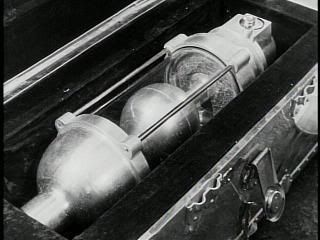
In order to stop Gojira, it dawns on Dr. Daisuke Serizawa (the late, great Akihiko Hirata) that he will have to create a weapon far worse than the one that created Gojira in order to destroy the beast (the dreaded OXYGEN DESTROYER!), and wonders if the mere existence of this new weapon will only serve to hasten the destruction of the planet it is supposed to save.

Serizaiwa’s exposition about brinksmanship seems nearly prophetic when you look at the events to follow in the Cold War. As much as I love the Godzilla franchise, I am somewhat saddened by Toho converting Gojira from a mirror darkly into a superhero, because the first film really is a lot more profound than most people give it credit for.
In Gojira and THEM, there is a lot of message and morale behind the respective threats to civilization.

In Gojira and THEM, there is a lot of message and morale behind the respective threats to civilization.

I suppose the most glaring difference in these movies is the portrayal of the military.
In the 50’s, the US Army enjoyed an unprecedented amount of respect as both World Wars solidified its role as savior of democracy. It was only fitting that the Army should be the ultimate protagonist that faced down any unnatural threat to mankind on the Silver Screen.
No matter if the Sci-Fi Golden Age film threat came from giant bugs, big lizards, or aliens in flying saucers, you could pretty much rest assured that Big Green would come out victorious in the end.

In the 50’s, the US Army enjoyed an unprecedented amount of respect as both World Wars solidified its role as savior of democracy. It was only fitting that the Army should be the ultimate protagonist that faced down any unnatural threat to mankind on the Silver Screen.
No matter if the Sci-Fi Golden Age film threat came from giant bugs, big lizards, or aliens in flying saucers, you could pretty much rest assured that Big Green would come out victorious in the end.

In THEM, you still have the military filling the role of protector of humankind, but by the same token you had Dr. Medford (Edmund Guenn) constantly making sinister insinuations about the ants serving as the US's comeuppance for creating the A-Bomb in the first place.
Bitter commentary, indeed. We had ourselves to thank for our pending doom because the ants were just as much our creation as the A-Bomb was.
In short, we asked to be eaten.
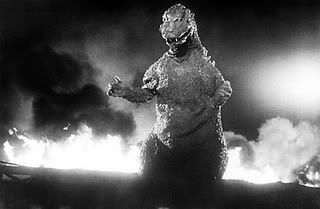
Bitter commentary, indeed. We had ourselves to thank for our pending doom because the ants were just as much our creation as the A-Bomb was.
In short, we asked to be eaten.

Gojira , on the other hand, takes a very cynical view of the military and conflict in general for that matter. No amount of conventional armed force is capable of stopping Gojira; he becomes less of a rampaging kaiju and more of a walking metaphor.
He is Mutually Assured Destruction given life. A colossal, fire-breathing, self-fulfilling prophecy.
As I mentioned before, there is also the intriguing philosophical undertone concerning the Oxygen Destroyer: the weapon used to kill Gojira.
Dr. Serizaiwa assumes (probably correctly) that the only redeemable trait about nuclear weapons is that they are so destructive that no one is foolish enough to use them for fear of obliterating themselves alongwith their enemies.
Serizawa's concern is that the Oxygen Destroyer will provide the world’s armies with the one thing they want most; a WMD with the destructive power of a nuclear weapon but without the nasty by-product of global annihilation..
Or so they think... After all, the damned thing works by splitting the atomic bonds in oxygen molecules, therefore making air unbreathable and fostering decay in cellular tissues.
It is the central message of "at what price?" that makes Gojira a powerful piece of work.
Regrettably, that message was swept away in the campy goodness of subsequent films in the series, but I'm not really complaining since I watch Destroy All Monsters (1968) at least once every three months.
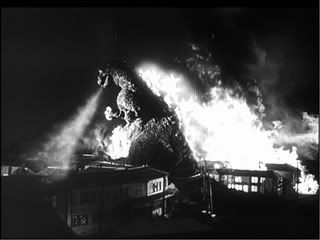
He is Mutually Assured Destruction given life. A colossal, fire-breathing, self-fulfilling prophecy.
As I mentioned before, there is also the intriguing philosophical undertone concerning the Oxygen Destroyer: the weapon used to kill Gojira.
Dr. Serizaiwa assumes (probably correctly) that the only redeemable trait about nuclear weapons is that they are so destructive that no one is foolish enough to use them for fear of obliterating themselves alongwith their enemies.
Serizawa's concern is that the Oxygen Destroyer will provide the world’s armies with the one thing they want most; a WMD with the destructive power of a nuclear weapon but without the nasty by-product of global annihilation..
Or so they think... After all, the damned thing works by splitting the atomic bonds in oxygen molecules, therefore making air unbreathable and fostering decay in cellular tissues.
It is the central message of "at what price?" that makes Gojira a powerful piece of work.
Regrettably, that message was swept away in the campy goodness of subsequent films in the series, but I'm not really complaining since I watch Destroy All Monsters (1968) at least once every three months.

I can’t imagine any serious schlock film buff not having seen either of these movies, but the uninitiated should definitely check out both of them. For those of you that have seen these films, perhaps this bit of analysis on my part will inspire you to watch these gems with a keener eye for the subtle.
Oh, and in case you're wondering about how this relates to Fallout 3, there is a quest in the game entitled THOSE! where the object is to stop a nest of fire-breathing giant ants from destroying a small settlement close to the DC ruins.
I don't think that it is coincidental that the opposition in the quest appears to be a gestalt of antagonists from two sci-fi movies released in the same year and dealing with creatures mutated by radiation, but again I may be overanalyzing things.
Oh, and in case you're wondering about how this relates to Fallout 3, there is a quest in the game entitled THOSE! where the object is to stop a nest of fire-breathing giant ants from destroying a small settlement close to the DC ruins.
I don't think that it is coincidental that the opposition in the quest appears to be a gestalt of antagonists from two sci-fi movies released in the same year and dealing with creatures mutated by radiation, but again I may be overanalyzing things.

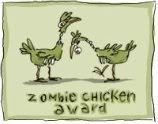








1 comment:
I always feel that when Japan discusses nuclear issues (even--or perhaps especially--in their art) that you should doubly appreciate the gravity of it. I mean, to everyone else, nuclear warfare is more-or-less a theory; for Japan, it's a lived reality.
I always find it odd, thinking that Japan is the only nation that's been nuked. The ways that that must change your perspective are unimaginable...
Anyway, I now must track down THEM. And play FALLOUT 3--even if it's not as morally ambiguous as its predecessors.
Post a Comment